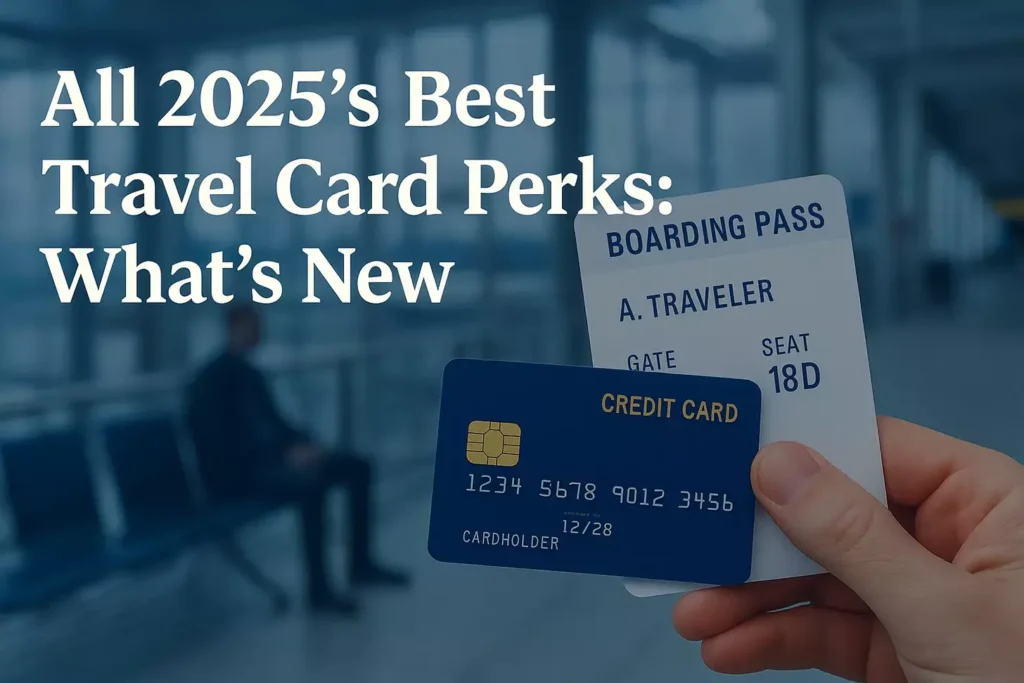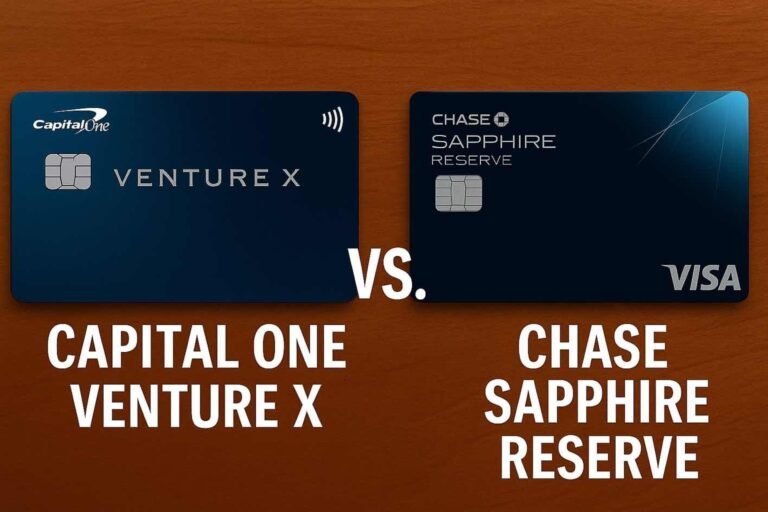Affiliate Disclosure: Award Travel Hub may earn a commission or referral bonus from some links on this site. These affiliate links help support our work and may influence the placement or promotion of certain products or services. However, our content is independently crafted to reflect honest opinions. Not all offers or products are included. There is no additional cost to users when they utilize our affiliate links.
“Travel and change of place impart new vigor to the mind.” — Seneca. We begin with that idea because small changes in how we use a card can unlock significant, practical savings for real trips.
Americans left about $15 billion in unused rewards last year — roughly $300 per cardholder. At the same time, premium annual fees rose by ~12%, yet issuers added value: lounge networks grew by ~25% compared to 2023, richer insurance options became available, and welcome offers topped 100,000 points in some cases.
We’ll show how strategic pairings of cards and everyday spending can net over $1,200 a year for many travelers. Our focus is pragmatic: highlight benefits you’ll use on your next trip — lounges, statement credits, stronger protections, and dynamic redemption paths across Chase, American Express, Capital One, and Citi.
Key Takeaways
- Issuers are increasing perks and welcome offers; opportunities exist if you match a card to your spending habits.
- Expanded lounge access and statement credits often offset higher annual fees for regular travelers.
- Maximize value by aligning earn rates and transfer partners with your usual routes and hotels.
- Many travelers still leave cash-equivalent value on the table; audit your cards annually.
- We evaluate rewards using transparent methods, ensuring you can trust the conclusions.
Editor’s Note: How We Built This Product Roundup for Fall 2025
We examined current welcome ranges, lounge rollouts, and insurance terms to measure traveler value. Our goal was practical: highlight perks that cut out‑of‑pocket costs or clearly improve a trip.
Data sources include public issuer disclosures, live offer samples, and mapping of the issuer ecosystem. Approval models often cite FICO ranges, but issuers use multiple scoring tools; approval is never guaranteed.
How we weigh benefits:
- Ease of redemption and destination coverage.
- Likelihood of usage for common trip scenarios.
- Transfer utility and lounge access growth since 2023.
Representative welcome offers we reviewed: 75,000 points after $5,000/3 months; 60,000 ThankYou points after $4,000/3 months; up to 175,000 Membership Rewards after $8,000/6 months. Offers vary by applicant and time.
| Offer | Threshold | Approx. Travel Value | Notes |
|---|---|---|---|
| 75,000 points | $5,000 / 3 mo | ~$750 | Flexible transfer partners |
| 60,000 ThankYou | $4,000 / 3 mo | ~$600 via portal | Good for point + portal mix |
| 125,000 points | $6,000 / 3 mo | ~$1,250 | High threshold, high upside |
We disclose affiliate relationships that may support our work. We strive for impartial, data-driven guidance, so readers can match cards to their real travel needs.

Fall 2025’s Best Travel Card Perks: What’s New and What’s Actually Useful
Annual fee increases have tracked higher, but many issuers offset that with clearer value on the first trip. We see a 12% rise in typical premiums, offset by larger statement credits and a wider lounge network.
What changed
Richer benefits, higher costs, bigger sign‑up bonuses
Issuers expanded lounge footprints by approximately 25% compared to prior years and enhanced insurance protections. Several cards now offer welcome bonuses of over 100,000 points, which can fund a short international trip or several domestic stays.

“Perks are only useful if you plan to claim them — prioritize credits you will actually redeem.”
The bottom line
Statement credits and travel credits often match or exceed the annual fee, so the math can work if you use the benefits. Optimized portfolios can deliver over $ 1,200 in yearly value through lounge access, credits, and improved point redemption.
| Shift | Impact | How to capture value |
|---|---|---|
| Higher annual fees | ~12% increase | Use credits within 90–120 days |
| Lounge expansion | +25% locations | Pick cards with networks on your routes |
| Bigger bonuses | 60k–100k+ points | Combine with transfer partners for flights |
The 2025 Rewards Landscape: Bigger Multipliers, Evolving Point Values
Many issuers now deliver 5x–10x on select categories. That shift changes how we earn points on everyday spend and planned trips. Portals and transfer networks now play different roles in redemption value.
Dynamic redemption: portal boosts vs. transfer value
Simple portal bookings typically cost around 1.25–1.5 cents per point. They suit fast bookings and fewer rules.
Transfers to frequent flyer partners can increase the cost to 2–3+ cents per point for premium cabins. That extra value requires flexibility, award availability, and sometimes surcharges.
Tiered earn structures and long‑term incentives
Issuers now layer monthly or annual thresholds with loyalty bonuses. Hitting a spend band can unlock higher multipliers or recurring statement credits.
- 5x–10x multipliers accelerate points accumulation on travel, dining, and partner spend.
- Portals offer convenience; transfers offer stretch for aspirational flights.
- Stacking multipliers with portal boosts and occasional transfer bonuses compounds value.
“Choose the route—portal simplicity or transfer complexity—based on timing, fees, and award availability.”
We recommend mapping your usual routes, favored transfer partners, and card earning tiers. That allows you to select redemption options that match your travel goals and credit habits.
Premium Travel Cards: When High Annual Fees Are Worth It
We recommend a high‑fee option only when benefits match how you move and spend. A single package of lounges, credits, and protections should cover most or all of the annual cost in the first year.
Key lounge and credit combos:
- Chase Sapphire Reserve: $300 annual travel credit plus Priority Pass access — suitable for frequent airport waits.
- American Express Platinum: broad lounge access, including Centurion Lounges and Delta Sky Clubs when flying Delta, plus multiple statement credits.
- Capital One Venture X: $300 Capital One Travel credit, Priority Pass, and access to Capital One lounges as a growing network.
Credits that actually offset the fee
We favor general travel credits over narrow airline incidentals. General credits can be applied to airfare, hotels, or bundled bookings, making them easier to use.
Protections that tip the balance
Top‑tier travel protections include primary coverage for rental cars and robust trip cancellation/interruption benefits. These can save hundreds during a single claim and often outperform separate insurance.
“If you fly frequently and redeem credits each year, premium cards often pay for themselves.”
Mid‑Tier Winners: Strong Value without the Sticker Shock
You can earn heavy rewards on dining and everyday spending without paying a top‑tier annual fee.
Our mid-tier picks strike a balance between earning, protection, and transfer utility, offering serious value.
Chase Sapphire Preferred — 5x via portal on travel, 3x on dining, streaming, and online groceries. It includes primary rental coverage and solid trip protections. Transfer partners allow you to convert points for higher-value bookings.
Citi Premier — 3x on air, hotels, restaurants, supermarkets, and gas, plus a $100 hotel credit that boosts first‑year value. The steady multipliers keep points flowing across common categories.
American Express Gold — 4x at restaurants worldwide and 4x at U.S. supermarkets (cap applies), plus 3x on flights. Monthly dining and Uber credits help offset the moderate cost for frequent diners.
- Earning focus: Dining and groceries drive real annual rewards for households that cook and dine out.
- Protections: Trip cancellation/interruption and primary rental coverage are available at this price tier, often saving hundreds when utilized.
- Strategy: pair a mid‑tier anchor with a no‑fee earner for non‑bonus purchases to maximize net points.
“Mid‑tier cards often deliver the best ratio of benefits to cost for regular travelers.”
No‑Annual‑Fee Standouts: Simple Earning, Solid International Use
Simple, no‑fee cards often quietly protect your wallet abroad while you focus on the trip. We recommend them for casual travelers, students, and anyone who wants a reliable backup to a premium account.
Why no annual fee matters: cards without yearly costs remove the carry cost and usually waive foreign transaction fees. That makes them ideal for overseas purchases and unpredictable terminals.
Foreign transaction fees and why $0‑fee cards matter abroad
Capital One VentureOne earns 1.25x on everyday purchases and 5x on hotels and rental cars booked via Capital One Travel. It has no foreign transaction fees and wide international acceptance, so it’s a strong travel companion.
Bank of America Travel Rewards pays 1.5x on all purchases. Customers in Preferred Rewards can boost their earnings by 25–75%, turning a no‑fee option into a surprisingly strong source of points and rewards.
Discover it Miles gives 1.5x on all spending and uses a First‑Year Miles Match to effectively double to 3x in year one. That makes it ideal for building a starter balance before moving to higher‑tier redemptions.
- Practical tip: carry at least one no‑fee card with no foreign transaction fees for terminals that reject other networks.
- Use the no‑fee option for pointable foreign POS charges, then redeem earned miles against trip costs.
- Pair a no‑fee card with a premium card to capture credits while avoiding surcharges abroad.
“A single, widely accepted no‑fee card can prevent surprise transaction fees and keep your points growing.”
Airline Co‑Branded Cards: Free Checked Bags, Priority Boarding, and More
Co‑branded airline products trade broad flexibility for predictable, on‑carrier benefits that add up fast.
Who benefits most: Travelers who fly one carrier often, check bags regularly, or value smooth airport experiences. A single free checked bag for you (and sometimes companions) plus priority boarding saves time and adds clear cash value.
Common perks and real examples
Typical benefits include a free checked bag, priority boarding, in-flight discounts, and increased mileage earning. United co-branded offers — for example, a 70,000-mile welcome plus 1,000 PQP after meeting spend — demonstrate how issuers layer bonus miles with status credits.
Trade‑offs are real: limited redemption flexibility and exposure to program devaluations can cut point value. To mitigate this, we recommend pairing an airline card with a transferable‑points card. That keeps options open when award space is tight.
- Practical tip: A family of four can save hundreds in round-trip baggage fees, quickly covering their annual costs.
- Some co‑branded products offer elite‑qualifying boosts; targeted spend can push you over status thresholds.
“Pick airline loyalty when your routes match the program—otherwise keep flexibility with transfer partners.”
Hotel Cards in 2025: Free Night Certificates and Automatic Elite Status
Hotel‑branded cards often include an annual free night certificate that can cover a weekend in an expensive city or a resort break. We view that certificate as a direct way to recoup a card‘s fee in a single redemption.
Automatic status typically adds late checkout, upgrade priority, and bonus points on qualifying stays. Those perks enhance short trips by making check-out easier and mitigating surprises at the front desk.
Marriott Bonvoy and short‑stay value
Marriott Bonvoy certificates can be beneficial on city weekends or during shoulder seasons. Pairing a certificate with earned points often stretches value across one to three-night bookings.
- Use certificates in high cash‑rate markets where a single night equals the certificate cap.
- Target shoulder seasons and events to amplify savings and avoid crowded peak pricing.
- Combine a hotel card with a flexible program to top up awards when space is limited.
“If your travel patterns don’t align with one chain, flexible rewards and transfer options may beat a co‑branded approach.”
Transferable Points Powerhouses: Chase Ultimate Rewards, Amex Membership Rewards, Capital One Miles, Citi ThankYou
Transferable programs convert routine spending into high‑value redemptions for flights and hotels. We focus on how to choose between portal convenience and partner awards.
Top transfer partners for premium cabins and hotels
American Express Membership Rewards partners with 20+ partners and frequently offers transfer bonuses that enhance the value per redemption. Citi ThankYou and Capital One also offer wide partner lists that unlock premium seats or boutique hotels.
Portal vs. partner: when to book which
Portal bookings offer predictable value: Chase Ultimate Rewards via Chase Sapphire Reserve returns ~1.5 cents per point, while Sapphire Preferred pays around 1.25 cents per point.
Transfers can exceed 2 cents per point for Business and First Class. That requires award availability and some flexibility.
- Portal — fixed value, easy checkout, no award rules.
- Transfer — outsized value with partner awards, but needs search skills.
- When to choose — use the portal for convenience and transfers for aspirational bookings.
Chase Ultimate Rewards and Sapphire value add‑ons
Chase Ultimate Rewards points are versatile. A Chase Sapphire card offers protections like primary rental coverage and clear portal boosts, simplifying redemption.
“Move points to partners when you can extract more value; use portals when time or availability is tight.”
What Really Saves Trips: Travel Protections You Shouldn’t Ignore
When plans derail, the difference between a refund and an out‑of‑pocket loss often comes down to your card’s fine print. We walk through the protections that most often save travelers real money and stress.
Trip cancellation, delay, and baggage coverage
Many leading cards include trip cancellation interruption benefits that reimburse prepaid, nonrefundable travel when a covered event occurs. That feature is often the highest‑impact protection for expensive itineraries.
Trip delay reimbursements typically kick in after a set time threshold and cover meals and lodging. Keep receipts and airline delay confirmations to support claims.
Baggage delay and lost baggage protections reimburse essentials or losses up to a per-day or per-trip cap. Note purchase windows and item types covered before you travel.
Rental coverage and medical evacuation
Primary versus secondary rental coverage is critical. Primary coverage on select cards lets you decline the rental agency’s CDW and avoid costly daily insurance. Secondary coverage requires you to use personal insurance first.
Some premium products include emergency medical evacuation. For remote or international trips, that benefit can be lifesaving and cost‑effective compared with standalone policies.
Quick claim checklist
- Pay with the covered card.
- Keep all receipts, boarding passes, and vendor communications.
- File with carriers or insurers first, as required, and then submit to your issuer.
- Meet claim deadlines and follow the issuer’s documentation checklist.
| Protection | Typical Trigger | Common Max Payout |
|---|---|---|
| Trip cancellation/interruption | Illness, weather, and covered events | $1,500–$10,000 per trip |
| Trip delay | Delay threshold (e.g., 6–12 hours) | $100–$500 per incident |
| Baggage delay/loss | Delay > 6–12 hours / lost luggage | $100–$3,000 total |
| Primary rental coverage | Decline agency CDW and pay with a card | Collision damage up to vehicle value |
“A protection you never use still matters — until the trip where you need it.”
Annual Fees vs. Annual Credits: Doing the Math in Fall 2025
A careful calendar of statement credits can convert an intimidating annual fee into predictable savings.
Many top‑tier accounts now include broad travel credit lines such as a $300 general travel credit, monthly ride or food credits, and airline or hotel incidentals. These credits often match or exceed the sticker price when used within the membership year.
Statement credits that exceed fees—and how to actually use them
We recommend starting with broad travel credit options first. Book one paid flight or hotel early in the year to trigger extensive credits and confirm they apply to your account.
Next, layer brand-specific incidentals, such as monthly dining, rideshare, or hotel program credits. If plans change, consider converting narrow credits to local uses, such as food delivery, to prevent value loss.
- Calendar credits by chunk: annual, semiannual, or monthly to avoid expiry.
- Prioritize general credits, then stack airline/hotel incidentals.
- Use a paid booking early to validate automatic reimbursements.
Don’t forget protections. When tallying ROI, include the real value of trip protections, such as cancellation and interruption coverage. A single covered claim can outweigh a year’s worth of statement benefits.
“Schedule credits, test one paid purchase, and count protections as part of the net return.”
| Item | Common value | How to capture |
|---|---|---|
| General travel credit | $200–$300 | Use for airfare, hotels, or portal bookings |
| Monthly incidentals | $5–$20/mo | Rideshare, streaming, delivery |
| Protections | $500+ per claim | Keep receipts, use the covered card to pay |
Redemption Strategies: Per‑Point Value, Transfer Partners, and Portal Boosts
Good redemption plans start by pricing a trip both ways: cash and points. That simple comparison tells you whether to use a portal or transfer points to an airline or hotel partner.
Stretching points for business class and aspirational hotel stays
Portal bookings offer stable value around 1.25–1.5 cents per point. They are fast, predictable, and often include fewer rules.
Transfers to partners can unlock 2–3+ cents per point for premium flights or high‑end hotels. That extra value usually requires flexibility and award availability.
“If cash fares are low, use portal boosts; if premium cabins are pricey but awards are open, transfer for outsized value.”
- Run a quick cents‑per‑point calc: (cash price − taxes)/points needed. Pick the higher return.
- Search for award space early and late; some premium seats are released last-minute or far in advance.
- Stack transfer bonuses with strong partner charts to achieve outcomes of more than 2 CPP when possible.
- Keep a small cash buffer for taxes and fees, and use the right card to maintain active protections.
- Utilize positioning flights or flexible dates to access better availability without overspending your budget.
We recommend a simple decision tree: compare cash vs. points, check partner availability, and only move points when the projected CPP beats the portal value. This approach ensures that redemptions are efficient and repeatable.
Best‑Fit Picks by Traveler Type
Start by matching your flying, staying, and spending habits to the cards that reward those behaviors most.
Frequent flyer: Pair a premium transferable‑points card with your preferred airline co‑brand. That combination provides lounge access, priority boarding, and on-carrier perks that complement elite status.
Hotel loyalist: Lean on co‑branded products with free night certificates and automatic status. Use Marriott Bonvoy certificates for short hotel stays to maximize the value of a single redemption.
International explorer: Prioritize no foreign transaction fees, broad lounge networks, and strong trip protections. These features cut costs abroad and reduce hassle during long itineraries.
Casual traveler: Start with low or no‑fee options that deliver steady earnings, basic protections, and simple redemptions. They keep annual travel costs predictable.
Points optimizer: Combine transferable ecosystems and co-brand pairings to stack category multipliers, transfer bonuses, and flexible redemption options.
“Align card choice with the next 12 months of trips and major expenses to capture the largest returns.”
| Traveler Type | Primary Focus | Example Strategy |
|---|---|---|
| Frequent flyer | Lounge + elite perks | Transferable + airline co‑brand |
| Hotel loyalist | Free nights, status | Chain co‑brand (Marriott Bonvoy) |
| International explorer | No fees, protections | No foreign transaction fees + lounge access |
Stacking and Pairing: Strategic Card Combos for Maximum Rewards
A well‑built card combo can convert everyday spending into premium flights and hotel nights. We outline practical pairings that enable you to earn efficiently, unlock lounge access, and transfer points where they matter most.
Chase trifecta with Ultimate Rewards for everyday and travel
The classic chase trifecta pairs a Chase Sapphire (Preferred or Reserve) with Freedom Flex and Freedom Unlimited. Use Freedom cards for high multipliers on everyday spending and funnel points into Sapphire to access the ultimate rewards portal and take advantage of partner transfers.
Amex ecosystem: Platinum + Gold + Blue Business Plus synergy
American Express works similarly: Platinum provides lounge access and premium credits, Gold boosts rewards on dining and groceries, and Blue Business Plus captures a steady 2x on everyday purchases. Pooling membership rewards allows us to choose between portal bookings or partner transfers, depending on the trip.
Co‑branded plus flexible points: free bags + transfer versatility
Pair airline co‑branded cards for free checked bags and boarding perks with a flexible points hub. That combo preserves on-carrier benefits while offering award optionality when routes or pricing make transfers more strategic.
- Capital One approach: use Venture X as the hub for lounge access and credits, plus no‑fee earners for incremental points and Capital One Travel bookings.
- Application sequencing: space new applications to hit welcome bonus thresholds without forcing unnatural spend.
- Annual travel planning: select the combination that covers your flights, hotels, and everyday expenses for the year to maximize net value.
“Stack strategically: one hub for transfer power, one for lounge access, and light no‑fee earners to fill gaps.”
Approval Basics and Fine Print: Credit Scores, Welcome Offers, and Issuer Rules
Approval odds for a new card often hinge on more than your FICO number. Issuers use multiple signals: income, existing relationships, recent applications, and internal scoring models. FICO guidance is directional; approval is never guaranteed.
Welcome offers vary by applicant, timing, and history. Typical examples range from 60,000 to 175,000 points with differing spend and window requirements. Some issuers enforce one‑time language or family rules that block repeat bonuses.
- Confirm current terms and eligibility before applying.
- Space applications to protect your score and meet minimum spend naturally.
- Use prequalification or soft-pull checks, where available, to gauge the odds.
“Issuer rules matter — a clean application strategy beats chasing every bonus.”
| Item | Typical Range | Practical Note |
|---|---|---|
| FICO guidance | Good–Excellent | Directional; issuers weigh other factors |
| Welcome offers | 60,000–175,000 points | May be targeted; confirm eligibility |
| Repeat bonus rules | 1–48 months | Check issuer family restrictions |
| Foreign transaction | Waived on many travel products | Verify before international use to avoid transaction fees |
We recommend reading the issuer’s fine print, planning timelines, and counting protections and credits alongside any bonus when judging a new application.
Conclusion
Choosing cards by habit and route converts credits and points into real, repeatable value. Aim your travel credit cards at the trips you will take most. Use a single hub for transferable points and a companion card for everyday earnings. When a welcome bonus or statement credit matches planned spend, the math becomes clear.
Right‑size your setup. Select a premium card only if you plan to use lounges, protections, and credits. Otherwise, consider mid-tier or no-fee options. Compare portal bookings to partner transfers each time to maximize the value of points and rewards. Revisit your mix annually and develop a 12-month plan that reduces friction and lowers costs.




